Essential Arts: Immerse yourself in a Griffith Park ‘Soundwalk,’ and cry along with us
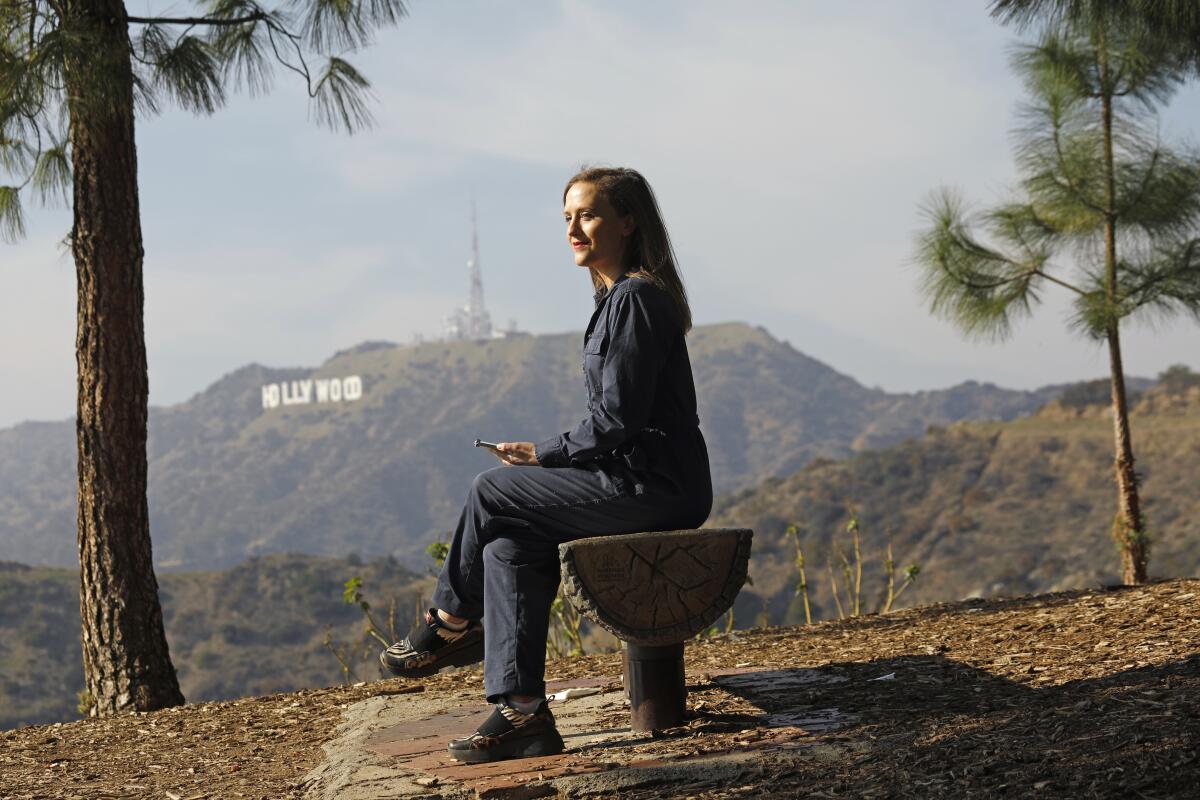
Feb. 20, 2021 — Sometimes you find yourself perched on a rocky overhang, dense with desert scrub brush, orchestral music filling the canyon below and tears slipping down your face.
I mean, right?
So went my recent reporting trip in Griffith Park, covering composer Ellen Reid’s new “Soundwalk.” Hi, I’m Deborah Vankin, an arts writer here at The Times, and I’m filling in for Carolina A. Miranda this week as your Essential Arts newsletter host.
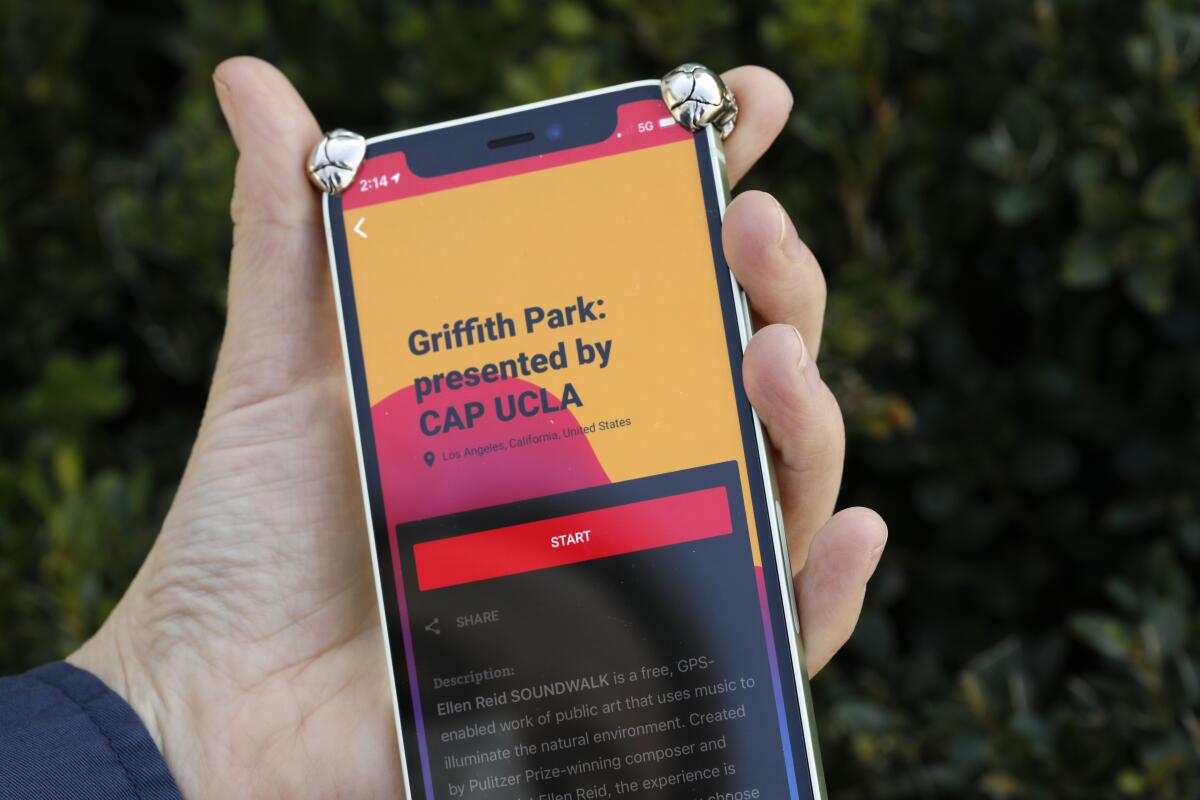
Reid, a 2019 Pulitzer Prize winner for her debut opera, “prism,” has scored more than 20 miles of Griffith Park, geotagging her original music to locations on the trails. The immersive public art project is accessible on a free app. To report on the project before it went live to the public Thursday, last week I downloaded a beta version of it on my phone, popped in my earbuds and began huffing and puffing up a steep Griffith Park trail. It was hazy and uncrowded; Reid’s lurching, melancholic choral music mixed with electronic sounds perfectly matched the surroundings.
I had expected the music to be uplifting and inspirational; I thought I might feel a surge of hope on this solo walk, something I’d not yet felt during the pandemic. I mean, I understood hope intellectually. COVID-19 infection rates were declining, my parents and stepparents had just been vaccinated, and I was grateful for that. But I hadn’t felt it. The waves of sickness and death over the last year, the hatred and divisiveness, the duration of the pandemic and sheer number of hours (days, sometimes) spent alone — I was having a harder time now than in the beginning. Hope hadn’t penetrated the emotional callous that had formed, the numbness.
The tag “immersive art” gets tossed around a lot these days to describe a vast range of experiences, often the “art” part obscured by the “immersive.” But thoughtful, nuanced experiential art has the power to truly transport us — or at least momentarily distract us — which is so useful right now.
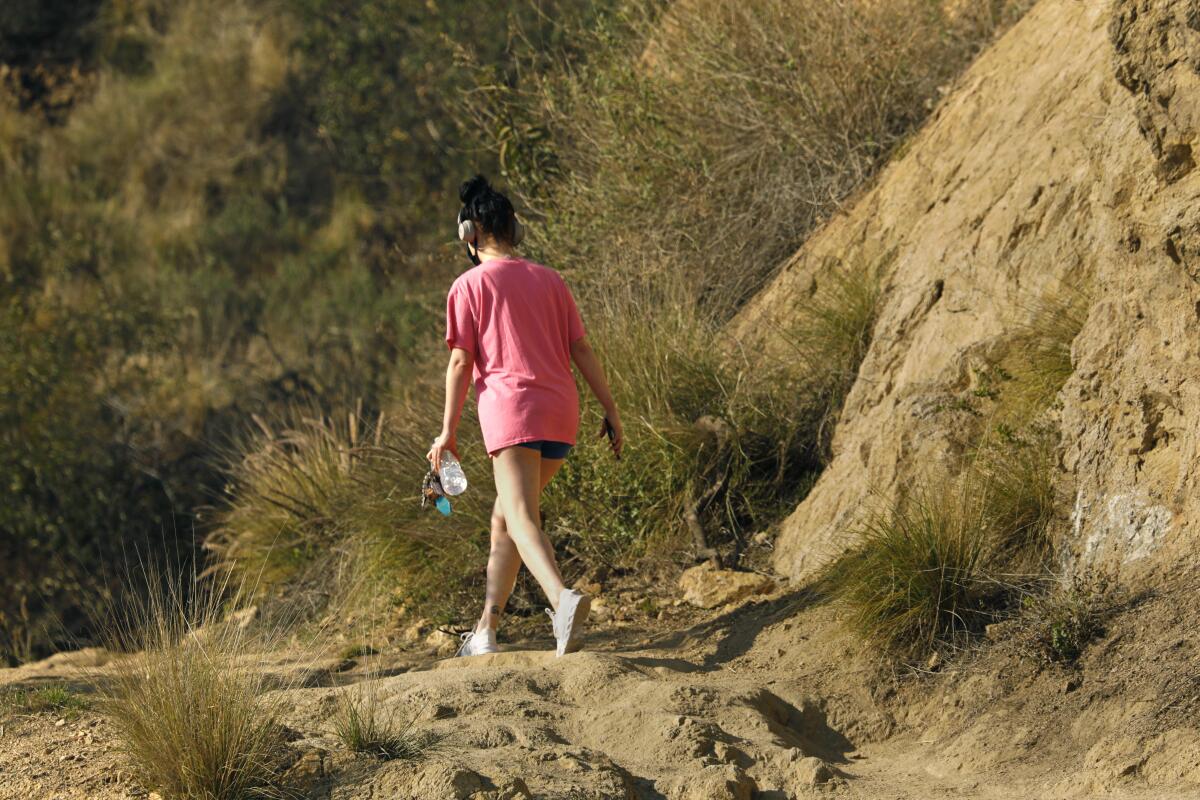
I stopped at the overhang, sat on the ground nestled between pine trees and took in the sweeping view of the city several switchbacks below. Reid’s orchestral melody swelled, cinematically; then it faded, replaced by quivering viola and cello strings that hung in the air. It sounds melodramatic; but what hasn’t been these last 11 months?
Then a sort of steadiness and calm washed over me. And the tears came, unexpectedly. Reid’s music had unlocked something in me. It wasn’t hope. It wasn’t quite relief, but something adjacent to it. Release. I’ll take it.
On the topic of immersive art ...
There’s no need to wait for “Immersive Van Gogh,” the art experience my Times colleague Julia Barajas reported will come to L.A. in May.
The Desert X art biennial, which stages large-scale, site-specific works across miles of the Coachella Valley, announced its project lineup this week — and Judy Chicago is among the participants. I chatted with Chicago about the colorful “smoke sculpture” she’ll present there. Desert X opens March 12.
And for the intrepid immersive art-goer unafraid of an enclosed indoor slide during a pandemic (!), Times game critic Todd Martens takes a look at Meow Wolf‘s 52,000-square-foot Omega Mart, which opened this week in Las Vegas. Depending on your perspective, he writes, it’s either “an art gallery, an indoor theme park, a bold statement on individual theatricality, a place to take lots of Instagram photos or the sort of indoor space that should be avoided at all costs for the non-vaccinated during a pandemic.”
Make the most of L.A.
Get our guide to events and happenings in the SoCal arts scene. In your inbox once a week.
You may occasionally receive promotional content from the Los Angeles Times.
Shenanigans from a museum (and John Waters)
Times art critic Christopher Knight has written much about struggling museums deaccessioning artworks during the pandemic. In his latest he takes on New York’s Metropolitan Museum of Art, which is considering selling off art to help pay off a projected $150 million operating deficit. That a museum with such deep pockets would resort to selling off paintings and sculpture to keep the lights on “is a stark admission of administrative failure,” Knight writes. And the Met’s wealthy trustees, who established a pandemic relief fund for the museum, have only raised a little more than $25 million.
Can art be both good and funny? That’s the question John Waters poses in his new art exhibition, “Hollywood’s Greatest Hits,” at Sprüth Magers gallery. Jordan Riefe talks with the iconoclast filmmaker about Joan Rivers’ face, runaway pimples and cosmetic surgery for pets. The answer to Waters’ central question, we’re guessing, is “yes.”
Classical moves
Times staff writer Jessica Gelt reports that the San Francisco Opera will hold two drive-in productions in April and May at the Marin Center in San Rafael. “There is an incredible reawakening of the arts ahead of us,” the company’s general director Matthew Shilvock said.
Gelt also reports that Gail Samuel, president of the Hollywood Bowl and chief operating officer of the Los Angeles Philharmonic, is headed to the 140-year-old Boston Symphony Orchestra as its first female president.
1970s architecture and a 2020s hospital
Mimi Zeiger profiles 87-year-old architecture photographer Wayne Thom, who’s the subject of a new book by Emily Bills, “Wayne Thom: Photographing the Late Modern.” The book covers the first 20 years of Thom’s work, and the photographs are stunning, a “nexus of color, form, texture and shape,” as Thom envisions his craft.
Dr. Scott Kobner, the 29-year-old chief resident at the Los Angeles County-USC Medical Center’s Department of Emergency Medicine, relied on essential tools during the pandemic: his Leica M6 and M10 cameras. The Times’ Hailey Branson-Potts reports on Kobner’s documentation of County-USC during the pandemic, which he chronicled on his days off, as well as the history of medical photography.
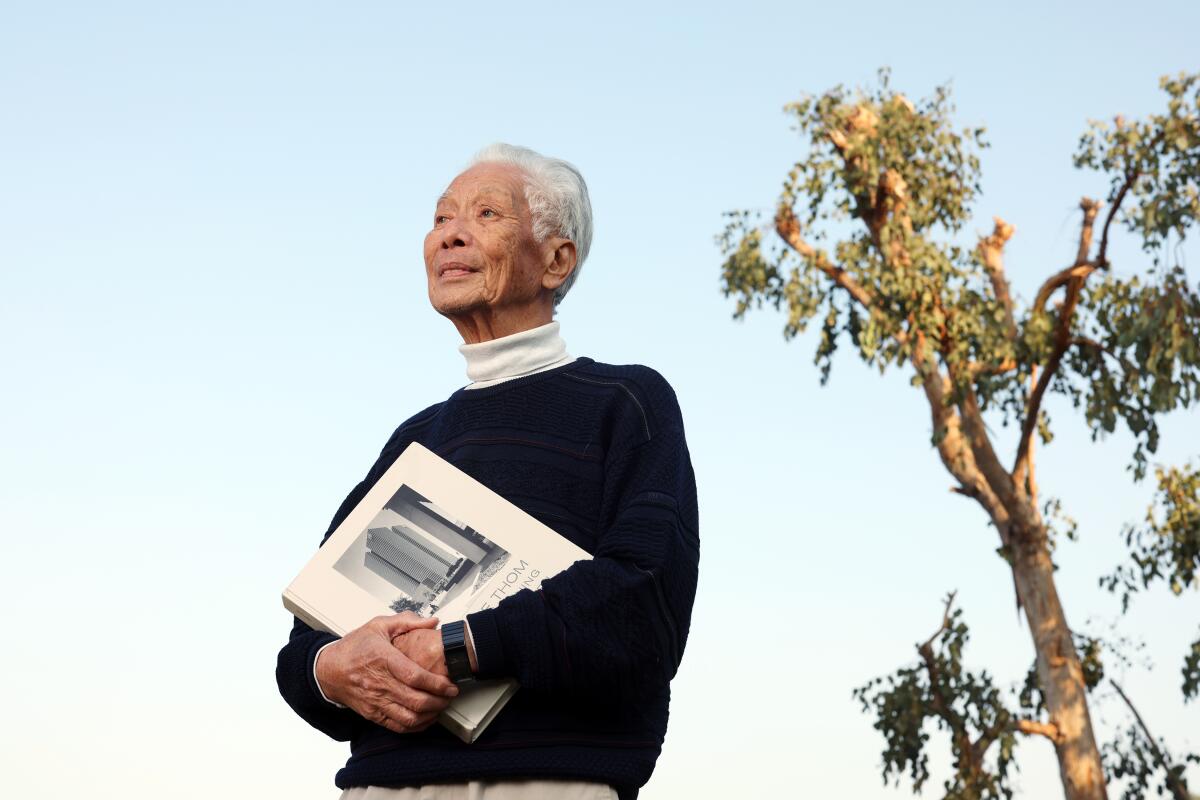
Art in books, and books about art
The new PMVABF might sound like a curious alphabet scramble, but it’s shorthand for Printed Matter’s first Virtual Art Book Fair, which runs Feb. 25-28. (The opening celebration is Feb. 24.) The fair includes more than 400 exhibitors from more than 40 countries, showcasing zines, artist books, rare books and more.
L.A. artist A.C. Esguerra’s much-anticipated graphic novel, “Eighty Days,” won’t be released until August, but The Times’ Tracy Brown has an exclusive interview with Esguerra — and a first look at some of the art in the queer historical romance.
Jessica Ferri reviews a new biography of Abstract Expressionist painter Helen Frankenthaler, “Fierce Poise,” by Alexander Nemerov (who, in addition to being an author and professor, is Diane Arbus’ nephew).
Art in memory
Paper cranes, felt roses, paper hearts. Artists and others are joining a grassroots movement to memorialize COVID-19 victims with handmade objects. The Times’ Alex Wigglesworth has the story.
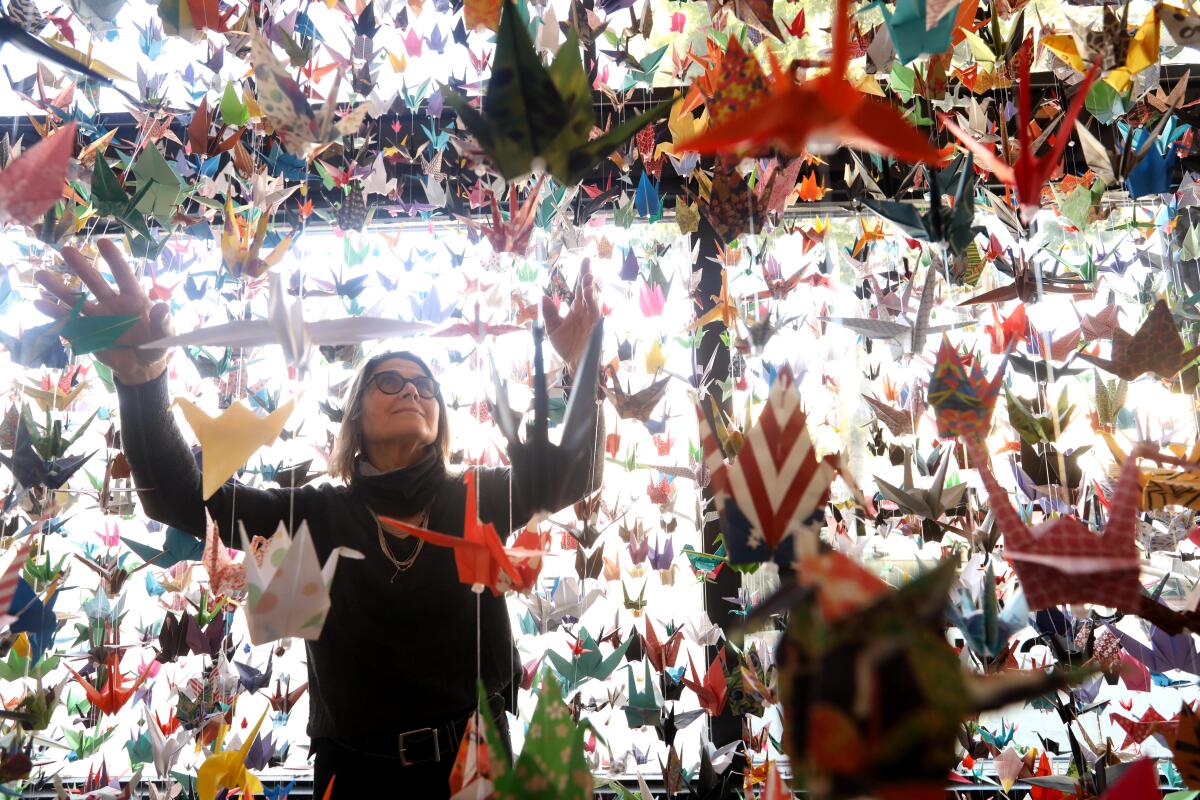
Essential events
What do activist-artist Ai Weiwei, comedian Patton Oswalt and NASA’s Mars Perseverance Rover all have in common? They’ve all caught the eye of Matt Cooper, our tireless culture scout, who has 17 streaming picks to keep you busy this weekend.
Also noted
Judith F. Baca’s more than half-mile-long mural, “The Great Wall of Los Angeles,” is getting greater. The Social and Public Art Resource Center, better known as SPARC, announced that it received a $5-million dollar grant over three years from the Andrew W. Mellon Foundation to expand the work.
“The investment is incredible and substantial for public art in Los Angeles,” SPARC Executive Director Carlos Rogel told me. “We’re really proud we get to return to the Great Wall and Judy can continue her vision there.”
The mural runs along Tujunga Wash, a concrete flood control channel in the San Fernando Valley, and it depicts overlooked indigenous, immigrant and minority histories in California from prehistoric times to the 1950s. Baca and about 400 teenagers completed the mural over the summers from 1976 to 1983. A restoration was completed in 2011. The expansion will include histories from the 1960s through 2020. The Mellon funds will also go toward creating better access to the mural from both sides of the Tujunga Wash.
“There are new segments focusing on each decade from the point of view of people of color, minority communities, women, LGBTQ experiences,” Rogel said. “Artistically, they’re a way of memorializing these critically overlooked events.”
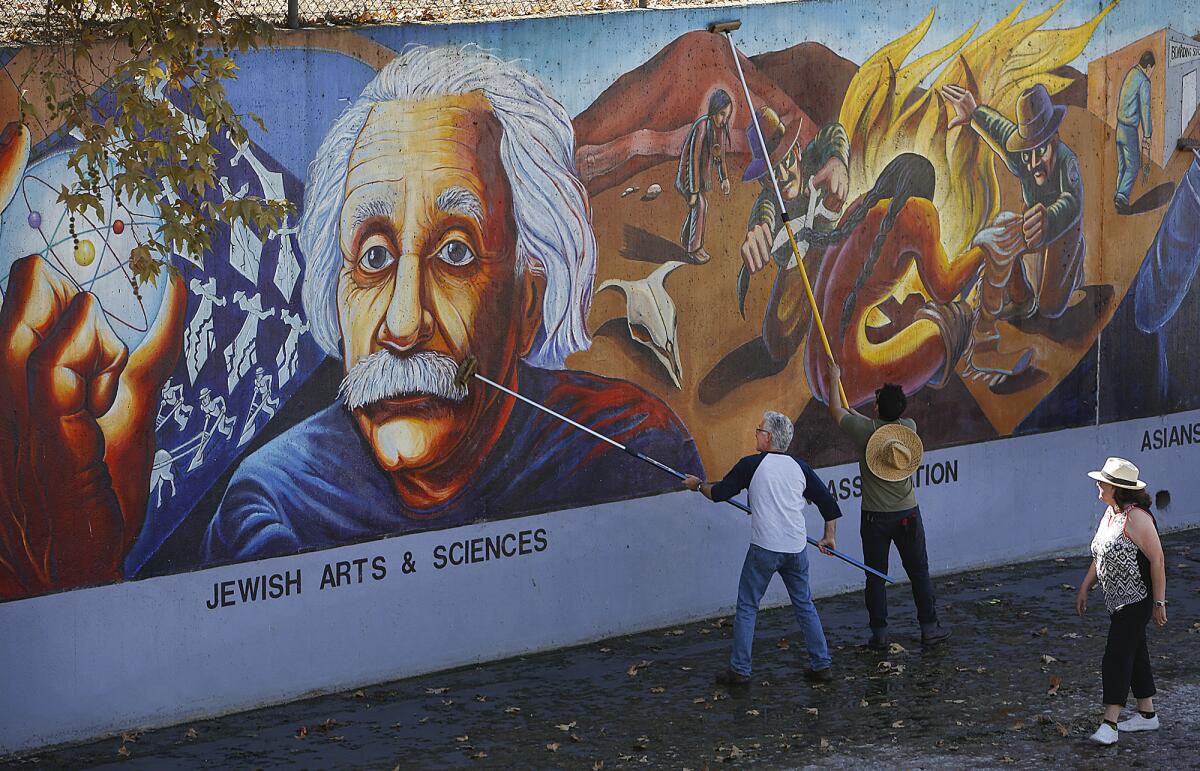
And, finally, for your listening pleasure ...
Here’s an audio clip of “Ellen Reid Soundwalk,” featuring Reid, her Soundwalk Ensemble and Eliza Bagg. Bring tissues.
The biggest entertainment stories
Get our big stories about Hollywood, film, television, music, arts, culture and more right in your inbox as soon as they publish.
You may occasionally receive promotional content from the Los Angeles Times.




